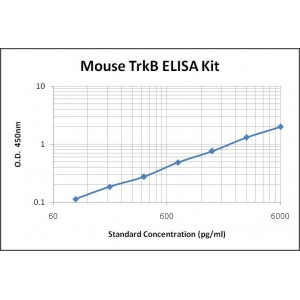More info
Assay Range | 93.8-6000 pg/mL |
Sensitivity | 5.0 pg/mL |
Specificity | No cross-reaction with other related substances detected |
Size | 96T |
Storage | Store at 2 - 8ºC. Keep reconstituted standard and detection Ab at -20 ºC |
Assay Principle | Sandwich ELISA |
Sample Volume | 100 µL final volume, dilution factor varies on samples |
Sample Type | cell culture supernatants, cell lysates and other suitable sample solution |
Detection Method | Chromogenic |
Kit Components
1. Recombinant Mouse TrkB standard: 2 vials
2. One 96-well plate coated with Mouse TrkB Ab
3. Sample diluent buffer: 12 mL - 1
4. Detection antibody: 1 vial
5.Streptavidin-HRP: 1 vial
6. Antibody diluent buffer: 12 mL x1
7. Streptavidin-HRP diluent buffer: 12 mL x1
8. TMB developing reagent: 10 mlx1
9. Stop solution: 10 mL x1
10. Washing solution (20x): 25 mL x1
Background
TrkB (Tropomyosin related kinase B), also known as TrkB tyrosine kinase or BDNF/NT-3 growth factors receptor, GP145-TrkB/GP95-TrkB or neurotrophic tyrosine kinase receptor type 2, is a member of the neurotrophic tyrosine kinase receptor family consisting of three members, Trk A, Trk B and Trk C. The Trk proteins share a common structure of a signal peptide, two cysteine-rich domains, a cluster of three leucine-rich motifs, two immunoglobulin-like domains in the extracellular region, as well as an intracellular region with the tyrosine kinase domain. Mouse TrkB shows 94% amino acid sequence identity with human counterpart, and both of them exhibit cross-species activity. TrkB is expressed primarily in the central and peripheral nervous systems. Low level TrkB expression has also been observed in a wide variety of other tissues. TrkB is a receptor for several "neurotrophins which include BDNF (Brain Derived Neurotrophic Factor), NT-4 (neurotrophin-4), and NT-3 (neurotrophin-3). Ligand binding will initiate homodimerization, autophosphorylation and activation of TrkB. Activated TrkB can then recruits, phosphorylates and/or activates several downstream effectors including SHC1, FRS2, SH2B1, SH2B2 and PLCG1. Through SHC1, FRS2, SH2B1, SH2B2, the GRB2-Ras-MAPK cascade is activated and regulates neuronal differentiation including neurite outgrowth. TrkB can also control the Ras-PI3 kinase-AKT1 signaling cascade that mainly regulates growth and survival via the same effectors. PLCG1 and the downstream protein kinase C-regulated pathways affect synaptic plasticity. Therefore, TrkB plays a role in learning and memory by regulating both short term synaptic function and long-term potentiation.


